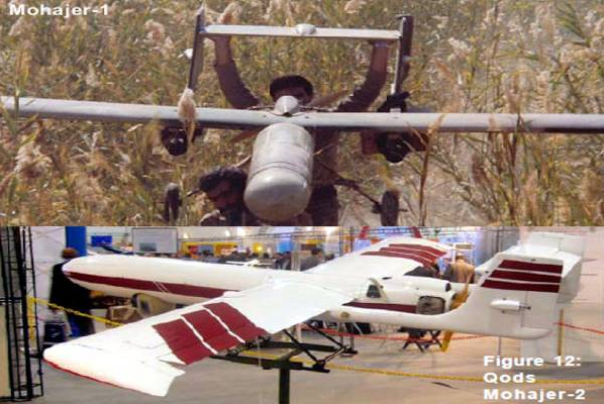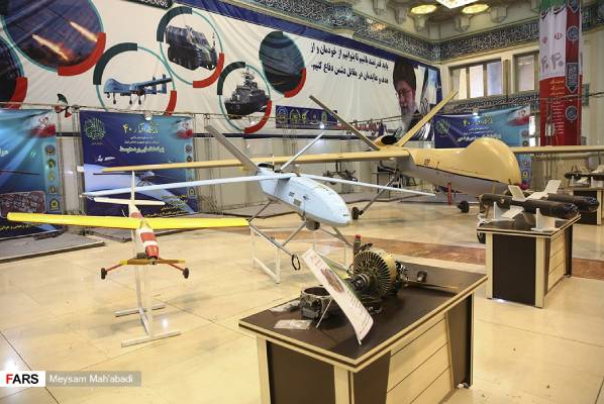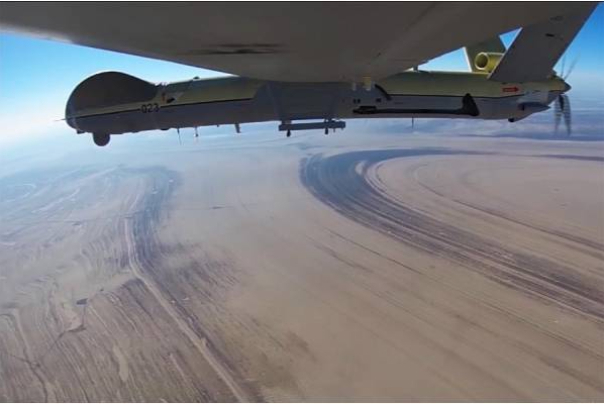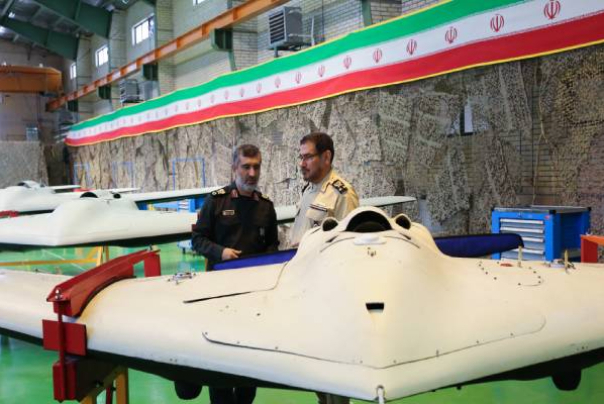NOURNEWS - The first history of UAVs in Iran was before the revolution and the purchase of fighter jets were from the United States. At that time, in order to test and evaluate air-to-air missiles and the ability to intercept these fighters (especially F-14 fighters), a number of US UAVs such as MQM-107 Striker and BMQ-74 Choukar were purchased.
After the revolution and the beginning of the imposed war, for a long time, the urgent need of the war fronts for aerial images of Ba'athist positions was met by reconnaissance and photography by RF-4 reconnaissance aircraft and at some point RF-5.
However, since reconnaissance fighters are unarmed, They were considered hunting targets for Iraqi interceptor and air defense fighters, Gradually, the idea of using model airplanes came to the minds of IRGC Air Force fighters in 1983, and it was decided that the country's air club would train IRGC forces in this field.
The first experience of using UAVs took place in the operational area of the fish farming canal, after which the "Thunder Battalion" of IRGC drones was stationed in Ahvaz and in a barracks near the fronts with the aim of providing IRGC reconnaissance images.
The simplicity of the emergence of photos and their up-to-dateness, high resolution images, wide shooting areas, low cost of flying and no need for special skills to interpret photos were among the features that soon clarified the efficiency and priority of UAVs for commanders, and because to that the Thunder Battalion has successfully upgraded the UAV unit by successfully building drones called Talosh 1, 2, and 3, and Muhajer 1 and 2.

By the end of the war, the IRGC's UAV Unit, with 940 air reconnaissance missions and 54,000 photographs, had identified 1,87070 square kilometers of operational areas and Ba'athist positions in terms of workload compared to the initial facilities, It is one of the most amazing achievement of the holy defense era.
Due to the successful and significant performance of this unit during the Holy Defense era, after the war, the development and strengthening of drone power although slow, was considered, until the early 80's with significant changes and growth in the production of Muhajer and Ababil family drones began in the two industries of Quds and Hesa, affiliated with the Ministry of Defense.
In parallel with these measures, in the early 1980s, the IRGC Air Research and Self-Sufficiency Jihad Research Center (now aerospace) began research and development work to produce reconnaissance, surveillance and combat drones, which led to the birth of the Shahed UAV family; The UAV family, which in recent years has carried out major reconnaissance and combat missions of the Armed Forces, both on the ground and on the resistance fronts, can be considered the proudest family of Iranian UAVs.
Shahed 121
Its first product, after several years of research, was produced and put into operation in the late 1980s as a "Shahed-121" reconnaissance drone.
Shahed-121 is a reconnaissance drone of the IRGC Air Force that has a flight duration of 10 hours, an operating radius of 700 km and a top speed of 180 km / h, and can also carry cargo weighing 30 kg.

Shahed 129
The second product of the Shahed family is the Shahed-129 fighter drone, which many military experts believe is one of the strategic and vital assets of our country's armed forces.
Shahed-129, which is the first Iranian combat drone capable of carrying out fire against ground targets using smart bombs and accurate guidance system, was unveiled in September 2012. With a 24-hour flight duration, the drone can carry out combat missions between 1,700 and 2,000 kilometers away from where it took off.

Shahed 129 can carry eight Sadid smart bombs and its flight altitude is 24,000 feet.
An advanced version of the Shahed-129, also known as the Iranian MQ-1, is a satellite guidance model that, according to the commander of the IRGC's air force, has increased its cargo capacity by 100 kilograms.
Shahed-129's brilliance in various operational scenes and its high combat capabilities attracted such opinions that in addition to the IRGC Air Force, last year the Navy also joined the users of this UAV and a number of them, called "Simorgh", were used to conduct naval and combat patrol operations in the third naval area of Nedaja pProphecy.
Shahed 191
The beginning of the 90's is the beginning of a new chapter in the development of the IRGC Air Force's drone capability, because in 2011 the news of the capture of the US RQ 170 drone, which at that time was one of the most advanced and at the same time the fastest US military technology. It was considered to be at the top of the world's media news.
After this action and the discovery and decoding of the data and information of this drone, the work of reverse engineering and production of this UAV gradually began in the Research Center and Jihad of Self-Sufficiency of the IRGC Air Force, and eventually, it led to the production of a newer range of modern combat drones.
Shahed 191 is an example of surveillance, reconnaissance, combat, and at the same time electronic warfare, modeled on the RQ-170 and in a smaller comparison.

This UAV, which has a turbojet engine, has a top speed of 300 km / h, a flight duration of 4.5 hours, a range of 450 km, a flight ceiling of 40,000 feet and a payload capacity of 50 kg.
Shahed-191 can also carry two Sadid smart bombs to carry out combat operations.
The distinctive feature of this drone is its tactical nature; This means that there is no need for conventional UAV launchers or even a runway to fly; The UAV flies in such a way that the UAV is mounted on a special position on a tactical vehicle, and this vehicle, by moving quickly on a smooth road, provides the necessary primary force for the UAV to fly, and after reaching the initial engine power, the drone is detached from its seat and takes off.
Another example of this UAV is Saegeh, which uses propeller engines instead of turbojet engines to power its propulsion, but at the same time has the ability to carry 4 Sadid smart bombs. The advantage of this flight method is that the drone does not need additional and common equipment to fly, and also from any point where there is only one flat surface for a car to move, like a street, a road, or even a city street, the attack bomber will be able to fly.

Shahed 133
Shahed-133 is another member of Shahed's family, about which no official information has been released yet, but according to the published images, it is a locust combat-drone capable of carrying two Sadid smart bombs and in the IRGC Air Force's UAV exercise last year, at least more than 20 of its aircraft were used.
Like the Shahed-191, the UAV has the ability to take off and land tactically and fly from a tactical vehicle.
Supreme leader's strategic advice to the IRGC Air Force
What has been said so far was to examine the capabilities of only one example of our country's drones, the Shahed family, which has been developed by the IRGC Air Force, Undoubtedly, other achievements of the UAV field, such as the family of "Mohajer" and "Ababil", which have become combat drones in our country's defense industry in recent years, another winning card of Iran is in the field of UAVs, but recently Sardar Amir Ali Hajizadeh, Commander of the Air Force of the Islamic Revolutionary Guard Corps, revealed a military strategy in the field of UAVs that has been proposed by the Supreme Leader of the Revolution.
Referring to one of the Supreme leader's recommendations for the use of combat drones, the commander of the IRGC Air Force stated: "In the meeting we had 3-4 years ago in the UAV area with the Supreme Leader of the Revolution, He implied the measures taken were very good, but the number of drones is small and we have to increase it. After that, we all mobilized to increase the number of drones."
The Supreme Leader's advice on drones is important because it shows the Commander-in-Chief's deep understanding of the realities of combat, even in specialized areas, such as the use of combat drones in offensive operations if a single invasion is made, is very unlikely to succeed if there will be more than one invasion. On the other hand, this can be compared to the tactics of mass assault on speedboats and the encirclement of targets from different angles, which is an innovation of the IRGC navy in the Persian Gulf.
On the other hand, the rejection of the implementation of this recommendation of the Supreme Leader regarding UAVs and its transformation into a strategy can be sought in March 2017.
Iran has become known as the owner of the largest fleet of offensive bomber drones in the region, with a large-scale exercise by IRGC air and combat drones known as the El-Beit al-Moqaddas-1 in the Persian Gulf and Bani-Farvar islands.
In this exercise, 50 different drones of the IRGC Air Force, including Shahed-129, Shahed-133, Shahed-191, flew in areas with an area of 10 km by 10 km. Air coordination and control by this number of unmanned birds in such a small environment has its own complexity.
Another important point of the "Eli Beit Al-Moqaddas-1" UAV exercise was the implementation of long-range operations by combat drones, which flew from the IRGC Air Force drone bases in Khuzestan, Fars, Bushehr and Hormozgan provinces over long distances, which in some cases up to 1,200 kilometers, and they hit their targets on the island of Bani Farvar.
Also in this exercise, in addition to the high volume of combat drones used, the accuracy of smart drones such as Sadid smart bombs was also significant in the accurate targets.
Iran's powerful drone demonstration during the IRGC Air Force's "Eli Beit al-Moqaddas-1" exercise and the unveiling of the largest fleet of attack bombers in the region was of such strategic importance that it did not escape the attention of the foreign media. In an article, the Zionist newspaper Jurusalem Post referred to the exercise as Iran's show of strength in the Persian Gulf.
The Israeli website Israel Defense, referring to the exercise, wrote: "The Iranian Air Force sent 50 fighter jets, including Saegeh, to an island in the Persian Gulf and near the Strait of Hormuz. The drones flew from various bases hundreds of thousands of kilometers into the area of operation to attack targets and successfully dropped their bombs on targets. This is the first time that so many Iranian drones have taken part in an exercise."
Referring to the development of armed drones around the world, the website wrote: "Iran has developed its own drone arsenal. The country is gaining operational experience and learning technology in battlefields, and is implementing them in the indigenous UAV industry."
The low cost of production, practical operating methods and techniques, including the use of automotive launchers, as well as the availability of a variety of weapons, are among the strengths of family drones that have proven their capabilities in recent years in real campaigns such as resistance fronts.
The use of Shahed drones in operations such as the Muharram strike in 2016 to target ISIL terrorist positions in response to the Ahwaz terrorist attack, the hunting of terrorist leaders in Iraq and Syria, and the thousands of hours of reconnaissance and combat flights of these drones in various operations definitely show the world that the Shahed family's UAVs can turn into a brand and a symbol of the country's drone industry; This is something that is hoped to happen in the near future so that the world becomes more familiar with one of the lesser-known dimensions of the deterrent power of Iran.
FARS